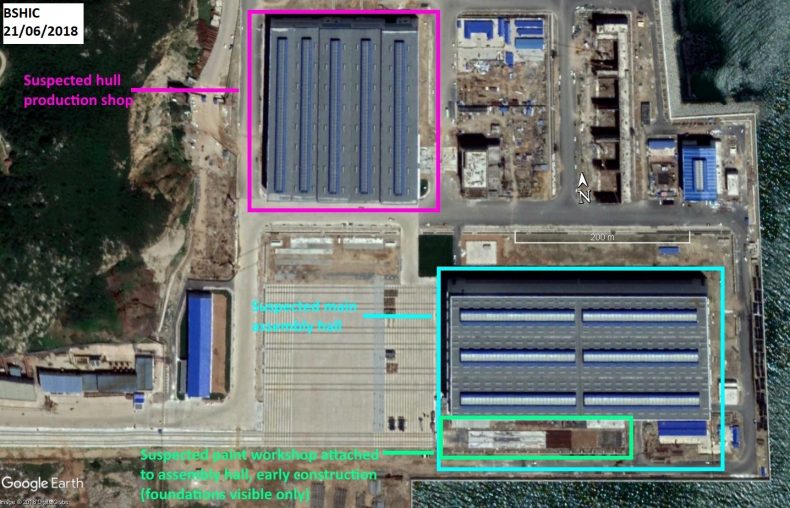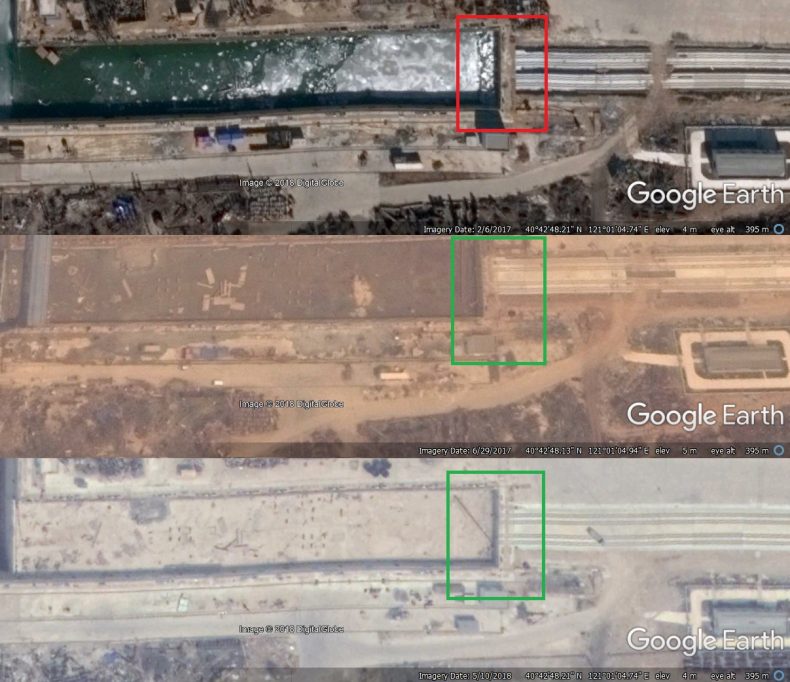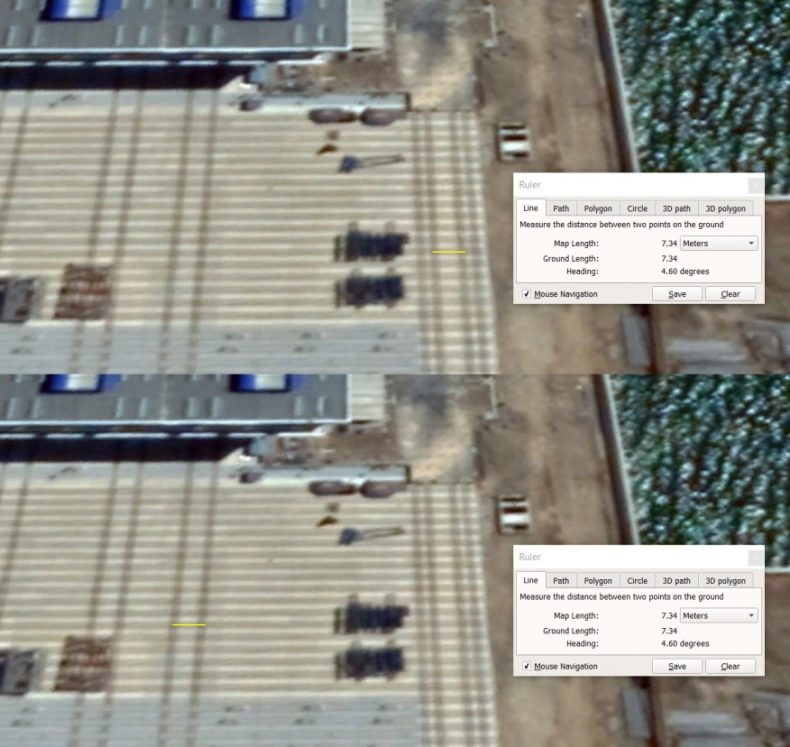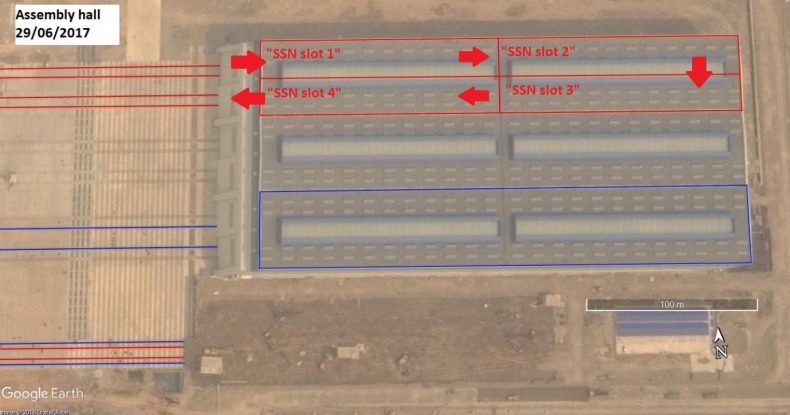@Bltizo's latest
Diplomat article:
Pondering China's Future Nuclear Submarine Production
What will Chinese nuclear submarine production look like in the future?
By
January 23, 2019
Recently a
of news
to Chinese
have been
. These include reporting on a test launch of a new submarine-launched ballistic missile (SLBM), as well as reviewing the number of Chinese ballistic missile submarines (SSBNs) and nuclear attack submarines (SSNs) in service.
A rumored new nuclear submarine production facility under Bohai Shipbuilding Heavy Industry Company (BSHIC) at Huludao may also be edging closer to completion. Therefore it’s a good occasion to reflect on what Chinese nuclear submarine production may look like in the future. Satellite imagery of Huludao and other nuclear production yards around the world will be examined to try and gauge the sort of production capacity the new Huludao may yield — if it is indeed for nuclear submarines. All satellite imagery is open source, acquired from Google Earth.
The Case Against Bohai
A number of
mid-2016 have
various new buildings and infrastructure constructed at BSHIC would become China’s new nuclear submarine production line. Huludao is home to BSHIC, China’s only shipyard that constructs nuclear submarines, and these new facilities were under BSHIC. Land reclamation at BSHIC has occurred since 2014, with a number of large foundations and buildings constructed (Figure 1), including a main assembly hall, a pressurized hull production shop, a painting shop, and a number of transport rails. Pictures within the newly constructed assembly halls also prompted some Chinese military enthusiasts to compare it with interiors of other nuclear production halls around the world.
Figure 1 – overview of the main BSHIC facilities, taken mid-2018. Note the rail lines.
However, a very well
by Capt. Chris Carlson, USN (retired) suggested the new facilities are not intended for nuclear submarines. The thrust of Carlson’s argument revolves around two main points.
First, rail lines from the new facility are blocked from reaching the main drydock due to a 6 meter concrete wall. Therefore newly completed submarines will be unable to be launched, as completed submarines would be far too heavy for drydock gantry cranes to lift.
Second, Carlson argues that the foundations atop the reclaimed land are insufficient to support large and heavy loads like submarines. SSNs can displace up to 8,000 tons and SSBNs over 15,000 tons, surfaced.
Examining the Arguments
Carlson’s first argument regarding the rail line reaching the drydock is very logical, as there is very clear past satellite imagery showing the rail lines did not reach the drydock’s edge. However, imagery taken in mid 2017 demonstrates the rail line had been extended up to the drydock’s edge, and all subsequent photos of BSHIC confirm this (Figure 2). The extended rail line virtually eliminates Carlson’s first premise, as there is now a direct transport path for completed submarines to the drydock, provided there is a floating drydock platform to receive hulls.
Figure 2 –the extension of the rail lines to the drydock
Carlson’s second argument is more difficult to evaluate. The accuracy of estimating the new facility’s load bearing capacity based on intermittent satellite imagery of the foundation’s construction is debatable at best. Not only is the imagery used for the estimates of less than optimal resolution, but months may pass between imagery updates on Google Earth, where substantial work may have occurred unobserved. For the purposes of this article, we will keep the plausibility of Carlson’s second argument in mind, but operate under the assumption that BHISC’s new facility could be for nuclear submarines.
Finally, the website East Pendulum has
and visits from staff associated with the Chinese nuclear submarine industry and the overall construction of BHISC’s new facility, further adding weight that it is intended for nuclear submarine production.
Examining the Rail Lines
Assuming that the foundations of the new facility are sufficient for bearing nuclear submarines, the most immediate question of interest is what submarine types the new facility can construct and how many could be constructed at any single time?
To answer this question, it is most instructive to first look at the main assembly hall. At 288 meters long and 135 meters wide, the assembly hall is further divided into three rows, which will be referred to as “production ways” for this article. Each production way is 288 m long and about 45 m wide (Figure 3).
Figure 3 – the overall assembly hall (green) is divided into three “production ways” (yellow)
With satellite imagery, it is possible to identify that each production way is further divided in half lengthways, because each production way has a pair of rolling doors as well as a pair of associated 7.34 m gauge rail lines leading into each door (Figure 4). In other words, each production way has two 7.34 m gauge rail lines, with each rail line composed of two tracks for a total of four “rail tracks” per production way.
A 7.34 m gauge rail line would be sufficient to accommodate a cradle necessary to support a 10-12 m beam submarine consistent with many contemporary SSNs, such as the U.S.
Virginia and
Seawolf classes or the U.K.
Astute class. Furthermore, one can also observe a 7.34 m gauge rail line leading out from the foundations of the future paint workshop toward the drydock, which makes sense as any complete SSN would be transferred to be painted before launch. Therefore, based on the 7.34 m gauge rail that leads out of the production ways as well as the paint workshop, it is possible to conclude that the new facility is very likely intended to produce SSNs with a beam of possibly 10-12 m. It is widely expected that the next generation Chinese SSN will be the 09V class.
Figure 4 – a 7.34 m gauge rail line leads into the future paint workshop, with two in each production way
However, the rail line leading from the paint workshop to the drydock is actually made up of two gauges. The first gauge is 7.34 m as previously indicated. However, a second rail line gauge is also present, at about 13.55 m wide (Figure 5). As previously mentioned, each production way features four “rail tracks” that make up two 7.34 m gauge rail lines; however, the central two “rail tracks” of each production way actually make up a 13.55 m gauge rail line as well, as confirmed on Google Earth’s measurement tool (figure 5).
Figure 5 – a 13.55 m gauge rail line also leads into the future paint workshop, with one in each production way
A 13.55 m gauge rail line is more than sufficient to accommodate cradles necessary for modern SSBNs such as the U.S.
Ohio class or Russian
Borei class, which have beams of 13 m and 13.5 m respectively. The next generation Chinese SSBN is thought to be designated the 09VI class, and may accommodate the new JL-3 SLBM. A 13.55 m gauge rail line may be capable of supporting even wider cradles for larger nuclear submarines in future, perhaps upwards of 18 m in beam; however this could merely be a case of future proofing the facility’s rail gauges as well.










